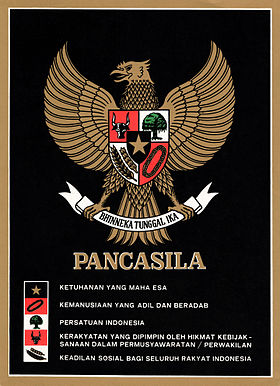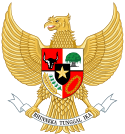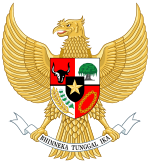Pancasila (politics)

Pancasila (Indonesian: [pantʃaˈsila] (![]() listen)) is the official, foundational philosophical theory of Indonesia.[1] Pancasila comprises two Old Javanese words originally derived from Sanskrit: "pañca" ("five") and "sīla" ("principles"). Thus it is composed of five principles and contends that they are inseparable and interrelated:
listen)) is the official, foundational philosophical theory of Indonesia.[1] Pancasila comprises two Old Javanese words originally derived from Sanskrit: "pañca" ("five") and "sīla" ("principles"). Thus it is composed of five principles and contends that they are inseparable and interrelated:
 |
|---|
|
| Original text | English translation[2] |
|---|---|
|
|
History[]
First iteration of Sukarno[]

Desirous of uniting the diverse archipelago of Indonesia into one state in 1945, the future President Sukarno promulgated Pancasila as the foundational philosophical theory of the new Indonesian state (in Indonesian "Dasar Negara"). His political philosophy was fundamentally an amalgamation of elements of monotheism, nationalism, and socialism. Sukarno consistently stated that Pancasila was a philosophy of Indonesian indigenous origin that he developed under the inspiration of Indonesian historical philosophical traditions, including indigenous Indonesian, Indian Hindu, Western Christian, and Arab Islamic traditions. "Ketuhanan" to him was originally indigenous, while "Kemanusiaan" was derived from the Hindu concept of Tat Tvam Asi, the Islamic concept of "fardhukifayah", and the Christian concept of neighborly love. Sukarno further explained that "Keadilan sosial", i.e. social justice, was derived from the Javanese concept of "Ratu Adil", i.e., the Just Leader, being a messianic Javanese ruler who would liberate people from all kinds of oppression. Pancasila was intended to resolve contrasting Indonesian Muslim, nationalist, and Christian priorities.

The iteration of Pancasila that Sukarno presented on 1 June 1945 to the Investigating Committee for Preparatory Work for Independence (Badan Penyelidik Usaha Persiapan Kemerdekaan (BPUPK)) [3] in a speech titled "The Birth of the Pancasila"[4] originally defined the Pancasila thus:[5]
- Kebangsaan Indonesia: Indonesian patriotism;
- Internasionalisme: Internationalism emphasizing justice and the virtue of humanity,
- Musyawarah Mufakat: Deliberative consensus emphasizing a form of representative democracy in which ethnic dominance is absent and each member of the council possesses equal voting power,
- Kesejahteraan Sosial: Social Welfare premised on the theory of the welfare state and emphasizing popular socialism, and
- Ketuhanan yang Maha Esa: A Divinity that is an ultimate unity" (A formulation that can be seen as implying both monotheism or pantheism, thereby allowing space for all of Indonesia's major religions).
Since 2015, 1 June, the anniversary of Sukarno's speech containing the first iteration of the Pancasila, has been a national public holiday.
Second iteration of the Founding Fathers[]

Sukarno gave the first iteration of the Pancasila in his speech of 1 June 1945 to the Investigating Committee for Preparatory Work for Independence (BPUPK),[3] and omitted the word "Indonesia".[6][7] The Committee of Nine (Panitia Sembilan), composed of Sukarno, Mohammad Hatta, Mohammad Yamin, Alexander Andries Maramis, Ahmad Subardjo, Ki Hadikusumo, Wachid Hasyim, Agus Salim, and Abikusno, formulated the second iteration of the Pancasila for the Jakarta Charter and the Preamble of the Constitution of Indonesia of 1945[8] by reordering their original enumeration by Sukarno thus: the fifth sila of monotheism and religiosity was promoted as the first sila; the second sila remained, the original first sila was re-numbered as the third sila, and the original third and fourth sila were re-numbered as the fourth and fifth sila.[citation needed] Sukarno accepted this proposition of the other members. Further, the first sila of the Jakarta Charter and the Preamble of the Constitution of Indonesia of 1945, being the first of the original sila of Sukarno, was amended to read "Ketuhanan dengan kewajiban menjalankan syariah Islam bagi pemeluk-pemeluknya" ("Belief in Almighty God with the obligation for its Muslim adherents to carry out the Islamic law/Syari'ah"). On 18 August 1945 the PPKI amended it further by deleting "with the obligation for its Muslim adherents to carry out the Islamic law/Syari'ah" and therefore left the first sila as simply "Ketuhanan Yang Maha Esa".[9]
The Constitution of Indonesia of 1945 defined the Pancasila as the fundamental principles of the independent Indonesian state.[6][10]
Interpretation by the New Order administration[]
Pancasila democracy endeavors to strike a balance between the interests of the individual and those of society. It seeks to prevent the oppression of the weak by the strong, whether by economic or political means. Therefore, we hold that Pancasila is a socio-religious society. Briefly its major characteristics are its rejection of poverty, backwardness, conflicts, exploitation, capitalism, feudalism, dictatorship, colonialism[,] and imperialism. This is the policy I have chosen with confidence.
— Suharto[11]
The New Order administration of Suharto, the second President of Indonesia, strongly supported Pancasila. His government promoted the five principles as a key national ideology. They were outlined as representing the ancient wisdom of the Indonesian people, pre-dating the introduction of foreign religions such as Hinduism and Islam. In a July 1982 speech which reflected his attachment to Javanese beliefs, Suharto glorified Pancasila as a key to reach the perfect life (Javanese: ilmu kasampurnaning urip) of harmony with God and fellow men.[12]
In 1978 Suharto secured a parliamentary resolution (Tap MPR No. 2/1978) on the Pancasila Appreciation and Practicing Guide (Pedoman Penghayatan dan Pengamalan Pancasila or P4) and later began a mandatory program to indoctrinate all Indonesians—from primary school students to office workers—for the application of the P4 and in living the national values. After initially being careful not to offend the sensitivities of Muslim scholars who feared that the Pancasila might develop into a quasi-religious cult, he secured another parliamentary resolution in 1983 (Tap MPR No. 11/1983) that officially made obedience to Pancasila mandatory to all organizations in Indonesia, public or private. In practice, however, the administration of Suharto exploited the vagueness of the Pancasila to justify its acts and to condemn opponents as "anti-Pancasila".[12]
Rationale[]
The formulation of Pancasila took place in the mid-20th century immediately after the end of the Second World War. Thus, the ideology reflects the socio-political conditions of the late colonial period in Indonesia and the ensuing war. Its concept derived and synthesized from the ideas and ideals of Indonesia's founding fathers, most prominently Sukarno's. The historical period that most influenced Indonesia's founding fathers was the socio-political conditions of the Dutch East Indies in the early and mid 20th century.
By the first half of the 20th century, some ideologies that had been established or made their way to the Dutch East Indies included imperialism and its antithesis anti-colonial nationalism, traditional Javanese statecraft, Islamism, democracy, socialism, and communism. Proponents of these ideologies had formed political organizations or parties to forward their respective causes. The Islamist party Sarekat Islam was established in 1905 followed by Masyumi in 1943. The Communist Party was established in 1914, while Sukarno's nationalist Indonesian National Party was established in 1927. Favoring one ideology over another would not satisfy the whole spectrum of Indonesian people, thus it was decided that the new republic need to synthesize a new ideology derived from indigenous Indonesian values as well as common shared values derived from various ideologies.[13]
Pluralism and inclusiveness[]
Indonesia is a multicultural nation, a diverse country composed of various ethnic groups with different languages, cultures, religions, and ways of life. The founding fathers had decided that the state ideology should encompass and shelter the whole spectrum of Indonesian society, in which a consensus for common good must be strived for and justice is served. As the result, Pancasila is often viewed[by whom?] as a form of pluralism and moderation, a potpourri of different ideologies, ranging from the socialist to nationalist and religious.
Some compromises were made during the formation of Pancasila to satisfy certain elements of Indonesian society. For example, despite its overwhelming Muslim population, Indonesia did not adopt political Islam nor proclaim Islam as its official religion, however, in line with Islamic religious belief, the Pancasila does specify monotheism as a mandatory tenet of any nationally recognized religion. Other than Islam, Indonesia only recognizes the following world religions:
- Christianity (Catholicism and Protestantism)
- Monotheistic Hinduism (generally in worship of a supreme being Acintya; this option commonly serves as an umbrella for various animist traditions)
- Buddhism, and
- Confucianism (added early in the 21st century).
The adoption of Indonesian instead of Javanese as the national language had practical value as a lingua franca and reduced concerns about favoring the Javanese majority.[14]
Pancasila was influenced by certain aspects of selected world values and ideologies, such as nationalism, humanitarianism, democracy, socialism, and religiosity.[13] The need to unify this diverse country also led to the formulation of the national motto, Bhinneka Tunggal Ika, which can be translated as unity in diversity. It declares the essential unity of its members despite ethnic, regional, social, or religious differences.[15]
Moderation and tolerance[]
In 1945, during the formation of Pancasila, there was much debate between nationalists who called for a pluralistic state and Islamists who wanted a religious state ruled by Islamic law or sharia. The nation's founders chose religious tolerance.[16] Pancasila encourage its proponent to practice moderation and toleration, thus radicalism and extremism are discouraged. In order to live harmoniously in a pluralistic Indonesian society, one's membership in a religious, ethnic, or social group should not dominate, discriminate, or be prejudiced in their relations with other groups.[16]
Interpretation[]
A commander of the 1st Military Regional Command/Bukit Barisan in 1966 describes Pancasila as a form of religious socialism.[17]
Criticism[]
The International Humanist and Ethical Union (IHEU), an atheist group, has criticized the first sila because it does not include a right to atheism, i.e., a rejection of theistic belief. The IHEU argued that this enables a culture of repression against atheists and that, as long as Indonesian law only recognized the religions of Buddhism, Confucianism, Hinduism, Islam, Protestant and Catholic Christianity, people who did not identify with any of them, including atheists, would "continue to experience official discrimination."[18]
Criticism of the Pancasila is forbidden by the criminal code because the national emblem of Indonesia includes the Pancasila. According to article 68,[19] its defamation carries a sentence of up to five years imprisonment or half a billion rupiah. In 2018, the controversial Islamic Defenders Front leader Muhammad Rizieq Shihab was charged under 154a and 320 of the Criminal Code on insulting the state ideology and defamation. The charges were later dropped.[20]
See also[]
- Armorial of Indonesia
- Pancasila economics
- National emblem of Indonesia
- Three Principles of the People
- The Six Arrows
- Rukun Negara
Notes[]
- ^ "Pancasila Plan to Affect Foreigners". The Jakarta Globe. Retrieved 22 September 2013.
- ^ Kosky Zakaria (ed) p43
- ^ Jump up to: a b Schindehütte, Matti Justus (2006). Zivilreligion als Verantwortung der Gesellschaft. Religion als politischer Faktor innerhalb der Entwicklung der Pancasila Indonesiens (PDF) (Thesis) (in German). Universität Hamburg. pp. 151–179.
- ^ Saafroedin Bahar et al. (1995), pp. 55–72.
- ^ Smith, Roger M. (editory) (1974). Southeast Asia: Documents of Political Development and Change. Ithaca and London. pp. 174–83.
- ^ Jump up to: a b Saafroedin Bahar et al. (1995), pp. 63–84.
- ^ Kusuma (2004), p. 1.
- ^ Saafrudin Bahar et al., 1995 and Kusuma, 2004.
- ^ Saafroedin Bahar et al. (1995), p. 301.
- ^ Kusuma (2004), pp. 150–66.
- ^ Suharto to G. Dwipayana and Ramadhan K. H., in Soeharto: My Thoughts, Words[,] and Deeds: An Autobiography, p. 194.
- ^ Jump up to: a b Ken Ward, 'Soeharto's Javanese Pancasila', Ch 2 in (August 2010). Soeharto's New Order and Its Legacy: Essays in Honour of Harold Crouch. edited by Edward Aspinall and Greg Fealy | ANUE PressEpress.anu.edu.au. ISBN 9781921666476. Archived from the original on 14 May 2013. Retrieved 22 September 2013.
(Harold Crouch)
CS1 maint: multiple names: authors list (link) - ^ Jump up to: a b Nanda Prasandi (25 September 2014). "Keunggulan Ideologi Pancasila". Kompasiana.
- ^ "The Invention of 'Lingua Franca', Language and Indonesian Nationalist Movement". Bahasa Kita. 11 May 2012.
- ^ "Bhineka Tunggal Ika". Bahasa Kita. 29 January 2011.
- ^ Jump up to: a b Jayshree Bajoria (7 July 2011). "Indonesia's view of tolerance is a blueprint for others". The National.
- ^ "Communist teachings do not recognize religious socialism". Angkatan Bersendjata. Medan. 3 January 1966.
- ^ "Pancasila Blasted for Repression of Atheists". The Jakarta Globe. 11 December 2012. Retrieved 24 May 2014.
- ^ "Undang-Undang Republik Indonesia Nomor 24 Tahun 2009 - Wikisource bahasa Indonesia". id.wikisource.org.
- ^ Post, The Jakarta. "West Java Police drop defamation charges against FPI leader". The Jakarta Post. Retrieved 12 July 2020.
References[]
- Kosy Zakaria, ed. (1999). Indonesia 1999: An Official Handbook. Jakarta: Indonesian Department of Information.
- Kusuma, RMAB (2004). Lahirnya Undang Undang Dasar 1945 [Birth of the 1945 Constitutution] (in Indonesian). Badan Penerbit Fakultas Hukum Universitas Indonesia: KITLV Press. ISBN 979-8972-28-7.
- Ricklefs, M. C. (1991). A History of Modern Indonesia since c.1300, Second Edition. MacMillan. ISBN 978-0-333-57689-2.
- Saafroedin Bahar; Nanie Hudawati Sinaga; et al., eds. (1999). Risalah Sidang Badan Penyelidik Usaha-usaha Persiapan Kemerdekaan Indonesia (BPUPKI) Panitia Persiapan Kemerdekaan Indonesia (PPKI) [Minutes of the Meetings of the Investigating Committee for Preparatory Work for Indonesian Independence (BPUPK) [sic] Preparatory Committee for Indonesian Independence (PPKI)] (in Indonesian). Jakarta: Sekretariat Negara Republik Indonesia. ISBN 979-8300-00-9.
- Sukarno (1949). Lahirnya Pancasila [The Birth of Pancasila] (in Indonesian). JYogyakarta: InGuntur.
External links[]
- Government of Indonesia
- Indonesian culture
- Nationalism
- State ideologies
